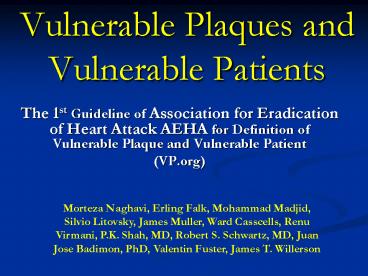Vulnerable Plaques and Vulnerable Patients - PowerPoint PPT Presentation
1 / 30
Title:
Vulnerable Plaques and Vulnerable Patients
Description:
Morteza Naghavi, Erling Falk, Mohammad Madjid, Silvio Litovsky, James Muller, ... Antithrombin III deficiency. Protein C or S deficiency ... – PowerPoint PPT presentation
Number of Views:1301
Avg rating:3.0/5.0
Title: Vulnerable Plaques and Vulnerable Patients
1
Vulnerable Plaques and Vulnerable Patients
- The 1st Guideline of Association for Eradication
of Heart Attack AEHA for Definition of Vulnerable
Plaque and Vulnerable Patient - (VP.org)
Morteza Naghavi, Erling Falk, Mohammad Madjid,
Silvio Litovsky, James Muller, Ward Casscells,
Renu Virmani, P.K. Shah, MD, Robert S. Schwartz,
MD, Juan Jose Badimon, PhD, Valentin Fuster,
James T. Willerson
2
Vulnerable plaques, vulnerable myocardium, and
hypercoagulable state of the blood lead to
sudden cardiac death and acute myocardial
infarction.
3
(No Transcript)
4
- Terminology
- Culprit Plaque
- a Retrospective Terminology
- Vulnerable Plaque
- a Prospective Terminology
5
Underlying pathologies of culprit coronary
lesions
- Ruptured Plaques (70)
- Stenotic (20)
- Non-stenotic (50)
- Non-Ruptured Plaques ( 30)
- Erosion
- Calcified Nodule
- Others / Unknown
MJ Davies, Circ. 1990 Falk et al. Circ. 1995
Virmani et al. ATVB 2000
6
Interchangeable Terminologies
YES NO
Vulnerable Plaque Vulnerable Plaque
High-Risk Plaque Soft-Plaque
Dangerous Plaque Non-Calcified Plaque
AHA Type IV Plaque
Non-Stenotic Plaque
7
Proposed Histopathological and Clinical Criteria
for Definition of Vulnerable Plaque
- Major Criteria
- Active Inflammation (monocyte/ macrophage
infiltration) - Thin Cap with Large Lipid Core
- Endothelial Denudation with Superficial Platelet
Aggregation - Fissured / Wounded Plaque
8
Proposed Histopathological and Clinical Criteria
for Definition of Vulnerable Plaque
- Minor Criteria
- Superficial Calcified nodule
- Glistening Yellow
- Intraplaque Hemorrhage
- Critical Stenosis
- Positive Remodeling?
9
Ideal method for screening vulnerable
plaque/patient
- Non-invasive
- Inexpensive
- Accurate
- Widely Reproducible
10
Diagnosis and Screening- Plaque Level
- Plaque inflammation (macrophage density or rate
of monocyte infiltration) - Matrix digesting enzyme activity in the cap (MMP
2, 3,9, etc) - Endothelial denudation or dysfunction (local NO
production, anti/pro-coagulation properties of
the endothelium) - Superficial platelet aggregation and fibrin
deposition (residual mural thrombus) - Plaque cap thickness with a resolution of lt100
micron - Collagen content, lipid core size, mechanical
stability (stiffness and elasticity)
11
Diagnosis and Screening- Plaque Level
- Calcification burden and pattern (nodule,
scattered, intimal, deep) - Angiogenesis, leaking vasa vaserum, and
intraplaque hemorrhage - Presence of certain microbial antigens
- Rate of apoptosis (apoptosis protein markers,
coronary microsatellite, etc) - Shear stress imaging (flow pattern throughout
coronary artery
12
Diagnosis and Screening- Systemic Level
- CRP, CD40L, ICAM-1, VCAM, and other serological
markers of inflammation - MMPs and acidic digesting proteinases and their
inhibitors such as TIMMPs and cystatin - Circulating apoptosis marker(s)
- Markers of blood hypercoagulability
13
Diagnosis and Screening- Systemic Level
- Markers of blood fibrinolysis
- Markers of lipid-peroxidation
- PAPP-A, pregnancy associated plasma protein A
- Plaque specific markers of immune activation
(anti-LDL Ab)
14
Screening
- A composite risk score
- Plaque vulnerability index
- Patient vulnerability index
- (e.g. VP Score)
15
Diagnosis- Active Inflammation
- Intravascular
- Thermography,
- CE-MRI
- FDG-PET
- Immunoscintigraphy
- Non-invasive
- CE-MRI (SPIO)
- Targeted CE-MRI, (macrophage specific Gd-labeled
Ab)
16
Dx- Thin cap and large lipid core
- Intravascular
- OCT
- IVUS
- High-resolution IVUS
- Angioscopy
- NIR Spectroscopy
- Elastography
- MRI
- IVUS-RF analysis
- Non-invasive
- MRI
17
DX-Endothelial denudation with superficial
platelet aggregation
- Intravascular
- OCT
- Angioscopy with dye
- Matrix-targeted / fibrin-targeted
immune-scintigraphy - Non-invasive
- Fibrin/Matrix-targeted CE MRI
- Platelet/fibrin-targeted SPECT
18
Fissured/Wounded Plaques
- Intravascular
- OCT
- IVUS
- High-resolution IVUS
- MRI
- Non-invasive
- Fibrin-targeted CE-MRI
19
Dx-Superficial Calcified Nodule
- Intravascular
- OCT
- High-resolution IVUS
- IVUS
- Non-invasive
- EBCT
- MSCT
- MRI
20
Yellow Color (in Angioscopy)
- Intravascular
- Angioscopy
- Transcatheter colorimetry
- Non-invasive
- Presently impossible
21
Dx- Intraplaque Hemorrhage
- Intravascular
- NIR Spectroscopy
- Tissue Doppler
- Non-invasive
- MRI
22
Dx-Stenotic Plaques
- Intravascular
- Invasive X-ray Angiography
- Non-invasive
- Non-invasive MS-CECT
- MRA w/wo contrast
- EBT Angiography
23
Blood Factor
- Antithrombin III deficiency
- Protein C or S deficiency
- Resistance to activated protein C (factor V
Leiden) - Antiphospholipid syndrome
- Nephrotic syndrome
- Platelet polymorphisms
24
Myocardial Factor
- Different cardiomyopathies
- Valvular disease
- Primary electric disturbances
- Chest trauma
- Anomalous origin of coronary arteries
- Myocarditis
- Myocardial bridging
25
Different Types of Vulnerable Plaque As
underlying Cause of Acute Coronary Events
Rupture-prone
Critical Stenosis
Hemorrhage
Normal
Fissured
Eroded
26
Rupture-Prone Inflamed Plaque
Vulnerable Plaque Type 1
27
Eroded Plaque with Exposed Proteoglycans Prone to
Thrombosis
Vulnerable Plaque Type 2
28
Fissured Plaque with Old and Fresh Overlaying
Thrombi
Vulnerable Plaque Type 3
29
Intra-Plaque Hemorrhage Prone to Thrombosis
Vulnerable Plaque Type 4
30
Asymptomatic Significantly Stenotic Plaque Prone
to Occlusion
Vulnerable Plaque Type 5

